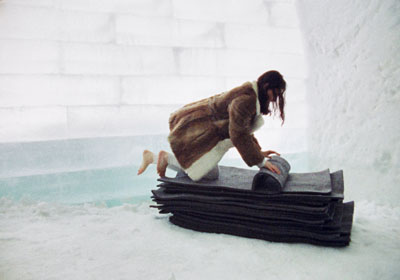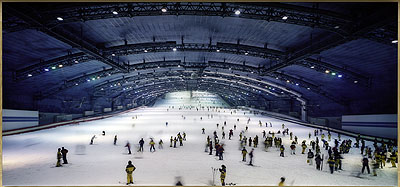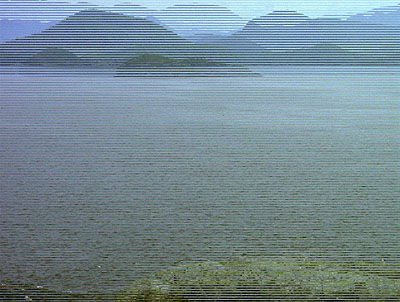
Palindrome, 2001 (film still)
16 mm color film transferred to video, with sound, continuous loop, 00:05:30
Courtesy the artist and Julie Saul Gallery
© Orit Raff
TRUE NORTH
Stan Douglas » Olafur Eliasson » Elger Esser » Thomas Flechtner » Roni Horn » Armin Linke » Orit Raff »
Exhibition: 2 Feb – 13 Apr 2008

Ski Dome, Tokyo, Japan (from the Global Box series, 1998–2000), 1998
Chromogenic print, face-mounted to acrylic, edition 5/5
101.6 x 219.2 cm
Courtesy Galleria Marabini
Solomon R. Guggenheim Museum, New York
Gift, Stephen Tobias 2005.5
© Armin Linke
True North features the work of seven contemporary artists whose photographic or video-based projects evoke the tradition of Northern Romantic landscape painting as well as its legacy in later nineteenth-century photography. Yet unlike their Romantic antecedents, the works in this exhibition are historically and politically self-reflexive and call into question the notion of a pure, unchangeable North. Melancholic in tone, many of these photographs and video projections point instead to a certain loss of purity; they connect supposedly untouched northern landscapes to protagonists who attempt to inhabit, colonize, or commune with the harsh nature of the North. Drawn largely from the permanent collection of the Solomon R. Guggenheim Museum, True North focuses on elegiac imagery by a group of international artists who have lived in or produced work about various northern locations, including the landscapes of Canada, Iceland, and the Netherlands. Whether present or strangely absent, the motif of the horizon recurs in much of the work included in True North. In Roni Horn's large-scale installation Pi (1997–98), a circular horizon of photographs depicts various cycles that take place in and around Iceland: a couple and their habitual viewing of the daytime soap opera Guiding Light, the life cycle of eider ducks, and the tidal conditions of the surrounding sea. Olafur Eliasson's The glacier series (1999) presents a serial grid of 42 images of vast glaciers, documented from a prop plane. Denying its Romantic connotations, the horizon is pushed to the edges of each frame. In Elger Esser's Ameland-Pier X (2000), however, the horizon line remains one of the only visible features of a dematerialized white landscape. Other works, such as Orit Raff's video Palindrome (2001) and Thomas Flechtner's Glaspass (Walks #10) (2001) detail the difficult futility of communing with a North that tests the limits of human influence and survival. Raff's female protagonist obsessively stacks felt in an attempt to create warmth—a futile gesture made all the more enigmatic by the juxtaposition of footage of a coyote comfortably navigating a frigid landscape. Often working in remote regions, Flechtner also questions the viability of humanity's presence in the frozen North. In Glaspass (Walks #10) he photographs his own ski tracks, which trace the topography of a barren snow-field. The skiers pictured in Armin Linke's Ski Dome, Tokyo, Japan (1998) on the other hand, enjoy an artificial North constructed within a now-demolished ski slope in the suburbs of Tokyo. True North also touches on the North's function as a site of political antagonism and historical repression. In his video installation Nu•tka• (1996), Stan Douglas uncovers conflict in the wilderness of western Canada by pairing various spoken texts, which include eighteenth-century narratives of colonization, with two staggered, opposing films of this remote region. Foregrounding the North as a site of traumatic loss, Douglas presents a landscape seemingly shattered by human strife. A place that most can only experience from a distance via various modes of mediation, the North as an idea presents an opportunity to examine the connection between reality and representation. Many of the works in True North probe this relationship, picturing a North that mutates, erases, or overwhelms.
True North präsentiert Werke von sieben zeitgenössischen Künstlern, deren Foto- und Videokunst Bezug nimmt auf die Tradition der romantischen Landschaftsmalerei sowie auf deren Echo in der Pionierzeit der Fotografie. Im Gegensatz zu ihren romantischen Vorläufern beziehen die gezeigten Arbeiten kritische Positionen zu Geschichte und Politik und widersetzen sich dem Ideal eines unberührten, unwandelbaren Nordens. In vielen der melancholisch gestimmten Fotos und Videoprojektionen klingt der Verlust einer ursprünglichen Reinheit an. Sie beleben die angeblich unberührte Landschaft des Nordens mit menschlichen Akteuren, die die unerbittliche Natur der Region bewohnen, besiedeln oder auf andere Art zu erfahren suchen. Die Exponate der Ausstellung, die zum Großteil der Sammlung des Solomon R. Guggenheim Museum entstammen, eröffnen einen elegischen Blick auf eine Gruppe internationaler Künstler, die an verschiedenen Orten des Nordens gelebt oder gearbeitet haben, unter anderem in Island und Kanada. Der Horizont – oder dessen Abwesenheit – zieht sich als Leitmotiv durch die Ausstellung. In Pi (1997–1998), einem raumfüllenden Rundpanorama aus Fotografien, beschreibt Roni Horn mehrfache Kreisläufe, die in und um Island ablaufen: Ein Paar lässt sich keine Folge der Fernsehserie Guiding Light entgehen, den Leistungszyklus der Eiderenten und die Gezeiten des Meeres. Olafur Eliassons The glacier series (1999) arrangiert 42 Bilder eines Gletschermassivs, aufgenommen aus einem Propellerflugzeug, in Form eines seriellen Rasters. Der gegen den Bildrand gedrängte Horizont unterbindet romantische Assoziationen. Hingegen bleibt die Grenze des Blickfelds in Elger Essers Ameland-Pier X (2000) das einzige wahrnehmbare Merkmal einer entmaterialisierten weißen Landschaft. Andere Werke, etwa Palindrome (2001) von Orit Raff oder Glaspass (Walks #10) (2001) von Thomas Flechtner, machen deutlich, wie aussichtslos alle Annäherungen an die Welt des Nordens sind, die extreme Anforderungen an die Handlungs- und Überlebensfähigkeit des Menschen stellt. Die Darstellerin in Raffs Video stapelt zwanghaft Filzmatten, um Wärme zu erzeugen. Ihr vergebliches Bemühen mutet noch rätselhafter an, wenn man es mit dem Verhalten des Kojoten vergleicht, der in eingeblendeten Filmszenen gewandt durch sein eisiges Revier streift. Flechtner, der häufig ferne Weltgegenden aufsucht, stellt die menschliche Anwesenheit in der Nordlandschaft infrage. Glaspass (Walks #10) dokumentiert die Skispur, die der Künstler in die topografische Kontur eines Schneehangs gezeichnet hat. Im Gegensatz dazu vergnügen sich die Skifahrer in Armin Linkes Ski Dome, Tokyo, Japan (1998) im künstlichen Norden einer inzwischen abgerissenen Skihalle am Rande Tokios. True North untersucht darüber hinaus die Funktion des Nordens als Ort des politischen Konflikts und der historischen Verdrängung. In der Videoinstallation Nu•tka• (1996) deckt Stan Douglas innere Widersprüche in der Wildnis Westkanadas auf, indem er zwei versetzte Filmaufnahmen des entlegenen Gebiets überblendet und mit verschiedenen gesprochenen Texten (unter anderem aus Entdeckerberichten des 18. Jahrhunderts) kombiniert. Douglas charakterisiert den Norden als Stätte eines traumatischen Verlusts, deren Landschaft von der menschlichen Zwietracht gezeichnet ist. Die meisten erleben den Norden nur aus der Distanz, durch Vermittlung diverser Medien. Als Idee bietet er indessen die Chance, die Beziehung zwischen Realität und Repräsentation näher zu bestimmen. Viele der Werke in True North erforschen diese Beziehung. Sie zeigen einen Norden im Wandel, der auslöscht, überwältigt oder wehmütig verschwindet.

Nu.tka., 1996 (installation view)
Single-channel color video projection and quadraphonic soundtrack, 00:06:50, edition 1/2
Dimensions variable
Solomon R. Guggenheim Museum, New York
Gift, The Bohen Foundation, 2000.59
Courtesy the artist and David Zwirner Gallery, New York
© Stan Douglas